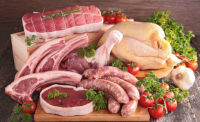Special Report | Economic Outlook
2020 Meat and Poultry Industry Economic Outlook: Weathering the storm
Experts believe continued gains in export markets in 2020 will enable further growth for the meat and poultry industry, despite the turbulence and turmoil around it.

Despite uncertainty over trade agreements, tariffs and bad weather, the poultry, pork and beef industries once again proved resilient in 2019. The reason? Strong domestic demand, pricing and increasing exports to China after the African Swine Fever (ASF) affected China’s hogs.
Opportunities in export markets are cautiously expected to improve in 2020, bolstering the meat industry.
“Broadly speaking, the trade wars have not stopped everything, but they have delayed opportunities,” says Derrell Peel, Ph.D., livestock marketing specialist at Oklahoma State University’s Cooperative Extension, based in Stillwater, Okla. “Their impact can take several months, but the effects will eventually catch up.”
Beef, pork and poultry all posted record production numbers in 2019, says Peel. And next year’s figures look to repeat themselves. So, domestic supply is certainly not an issue. And prices appear to be steady as long as the economy holds.
According to the U.S. Department of Agriculture’s (USDA) Livestock, Dairy and Poultry Outlook from May, commercial beef production is expected to reach 27.5 billion pounds in 2020, almost 1 percent greater than 2019’s record-setting numbers. In fact, beef consumption could reach 57 pounds per capita over the next few years, according to CattleFax, based in Centennial, Colo.

“Meat production has increased while domestic demand has remained pretty good,” Peel says. “The industry continues to move meat internationally and domestically, despite record levels of production.”
Pork production also is expected to reach record levels with 28.6 billion pounds (up 3.8 percent) and 29.3 billion pounds (up 2.3 percent) in 2020 and 2021 because of increased pigs per litter, reports the Livestock Marketing Information Center (LMIC), based in Lakewood, Colo.
“The U.S. pork industry performed well in 2019, but that performance was a disappointment to many due to very high expectations for U.S. pork exports to China,” says Steve R. Meyer, Ph.D., an economist with Kerns and Associates, based in Ames, Iowa.
Pork producers were profitable, however. “According to our profit model, the lowest-cost 20 to 25 percent of producers will make roughly $12/head based on CME Group lean hogs, corn and soybean meal futures in early November (2019),” Meyer says. “Average producers would be just better than break-even for 2019 based on this same model.”
The USDA’s World Agriculture Supply and Demand Estimates (WAGDE) also predicts a good year for poultry production in 2020 — 51.006 billion pounds, which would be an increase of 860 million pounds. Turkey production should hit 5.925 billion pounds next year, an increase of 36 million pounds.
In November it was announced that China will lift its ban on U.S. poultry imports, which has been in effect since January 2015 when an avian influenza outbreak hit U.S. birds. The United States has been free of this disease since August 2017.
“This action represents a significant opportunity for U.S. chicken producers,” says Tom Super, senior vice president of communications at the National Chicken Council, in Washington, D.C. “At its peak, the annual value of poultry exports from the U.S. to China was $722 million for chicken. Renewed access to the Chinese market could result in $1 billion annually for chicken paws alone and, due to China’s meat protein deficit as a result of African Swine Fever, there could be as much as another $1 billion of potential exports of other chicken products, including leg and breast meat.”
Combined poultry and red meat consumption could reach more than 225 pounds per person in 2020, compared with about 220 pounds in 2018, Super says.
“For consumers to be motivated to eat about five more pounds of poultry/red meat in 2020 will require a continued good U.S. general economy, low unemployment and retail poultry/meat prices favorable to consumers,” Super says.
Pork: Battling trade uncertainties
Yet, this year has been difficult for pork producers as they faced uncertainties over trade disruptions and the possible effect of ASF in China.
“Tariffs stand out as the industry’s largest challenge,” says Meyer. “They have left the U.S. as the least favored supplier of pork to China.”
U.S product is profitable in China even with the added tariffs, but it is less profitable than pork from any other supplier to China, Meyer says.
“Exports were weak to start the year, with a year-over-year decline in shipments to Mexico, Japan and South Korea,” says Christine McCracken, executive director of animal protein at Rabobank Food and Agribusiness, in New York. “By mid-year, however, exports moved higher as trade disputes with key partners in Mexico and Canada were resolved and U.S. trade partners became more concerned with global protein availability as a result of ASF.”

It’s estimated China has lost more than 50 percent of its swine population to ASF, reported Rabobank.
“The magnitude of the losses to ASF in China is mind-boggling,” Meyer says. “But it remains to be seen how much of this pork shortfall will be replaced with imported pork as chicken and beef take larger shares.”
There’s clearly a market for pork in China. Chinese consumers ate, on average, 88 pounds of pork, 19 pounds of chicken and 10 pounds of beef prior to 2019, Meyer says.
“In general, the United States is the last place China would reach out to for pork, but the country has to fill the gap in product,” Peel says.
U.S. pork exports have nearly doubled to China since last year, yet volumes are still disappointing.
“The ongoing trade dispute with China and corresponding tariffs — which averaged 72 percent for much of the year — have limited shipments,” McCracken says.
Despite this, China is now the second-largest export market for U.S. pork and pork variety meats, and is likely to challenge Mexico for the top spot in 2020, she says.
U.S. exports to Mexico should grow next year as well, because retaliatory tariffs hurt our shipments to Mexico in the first half of 2019 but are no longer an issue.
“However, until USMCA (United States-Mexico-Canada Agreement) is formally approved, this remains a key risk to our outlook,” says McCracken. “Mexico remains our largest pork export market and a critical partner in global trade, while Canada remains a top five-export destination and a key supplier.”
Next year, U.S. exports to Japan should also improve, due to the U.S.-Japan Trade Agreement announced this fall. “U.S. pork exports also faced tariffs on shipments into Japan — historically our second-largest pork market — for much of the year, while key export competitors that are members of the Comprehensive and Progressive Agreement for Trans-Pacific Partnership (CP-TPP) saw more favorable trade terms,” McCracken says.
Domestic demand has been higher this year than in 2018; however, pork faced an intense battle for the center of the plate as chicken and beef registered record levels of production. “While pork held its own and maintained a strong share in both foodservice and retail channels, it failed to gain any significant ground,” McCracken says.
Feed costs have been very close to those of the past four years and are expected to be close to those levels again in 2020.
“The health of the U.S. herd is about as good as it has been in recent memory with PEDv (Porcine epidemic diarrhea virus) incidence in sow herd near zero and PRRS (porcine reproductive and respiratory syndrome) incidence in sow herds at its lowest level since 2009, according to the University of Minnesota,” Meyer says.
Producers certainly had opportunities for profit this year, and margins were better than many expected at this time last year.
“Growth in U.S. retail channels could be more challenging in 2020 given plentiful supplies of chicken, yet we continue to see opportunities for value-added and prepared pork products,” says McCracken.
Broiler: Making a comeback
The broiler industry made a comeback in 2019 after suffering heavy losses in the second half of 2018. “In 2019, profitability returned, largely on the back of much better dark-meat prices — legs, thighs, etc.,” says Katelyn McCullock, director at LMIC. “Breast prices have struggled this year and have been working against gains made in other cuts.”
The whole-bird market has also struggled since the third quarter of 2018, McCullock says. “We expect dark-meat prices to remain steady to higher in 2020,” she says. “It appears U.S. tastes and preferences have shifted away from breast meat in the short term, and we expect those prices to struggle next year as well.”
Evolving U.S. demographics are shifting consumer preferences from white meat to dark meat, creating new opportunities for the poultry industry to diversify its profit centers, says Tom Tabler, Ph.D., extension professor at the Department of Poultry Science at Mississippi State University, in Starkville, Miss.

“There are two key demographic drivers behind the slow — but for the most part, steady — shift in demand from white to dark meat: age and ethnicity,” Tabler says.
The U.S. remains the largest producer of broiler meat in the world (with Brazil as the runner up). But the rate of growth seen over the past five years has slowed.
“However, there are still new complexes coming online,” says Tabler. “Sanderson Farms Inc. opened a new complex in Tyler, Texas, in 2019. Costco opened its own poultry complex in Fremont, Neb., in September 2019. Tyson Foods Inc. plans to bring a new complex in Humboldt, Tenn., online in late 2020.”
Domestic demand for chicken is still strong, whether it’s white or dark meat. “One record that continues to be broken annually since 2013 is chicken consumption,” says Super. “Per capita chicken consumption in 2019 is slated by USDA to be 94.5 pounds, another record high.”
Boneless, skinless thighs continue to gain acceptance by consumers both as a product itself and as the primary ingredient in chicken sausages, breakfast and gourmet, Super says.
In addition, most integrators have at least a portion of their production in antibiotics-free programs. “The entire country is not going to pay the extra costs associated with ‘No Antibiotics Ever’ chicken,” says Tabler. “However, there is a portion of the population that will pay the added costs and integrators are striving to provide consumers with what they are demanding.”
Weather is always a wildcard. “Feed costs are roughly 70 percent of the cost to bring chickens to market and poultry integrators always have their eye on weather conditions from planting season through harvest time,” Tabler says.
The tariff situation weakened the poultry export market to some extent in 2019. “However, with the recent outbreak of African Swine Fever in China, much of Southeast Asia and other parts of the world, poultry exports may stand to benefit as these locations look to replace pork with another meat protein source,” Tabler says.
Export demand could add to already strong domestic demand and keep broiler profitability in the black.
“Domestic demand continues strong in part because poultry competes well against beef and pork at the grocery store and in fast-food outlets,” Tabler says.
Turkey: Returning to seasonal patterns
Turkey exports still haven’t recovered since its birds were hit with avian flu in 2015. “That said, we’re seeing encouraging signs that might set us up for a positive 2020,” says Joel Brandenberger, president and CEO at National Turkey Federation, based in Washington, D.C. “In August, we exported 58 million pounds of turkey, a 21 percent increase year over year.”
The significant easing of U.S./China trade tensions is a positive change.
In addition, the U.S.-Japan Trade Agreement stipulates Japan will eliminate its 3 percent tariff on turkey, Brandenberger says. “We have reason to believe we’ll see exports increase to Japan,” he says.
“We also see a return to more seasonal patterns in the turkey market for the first time in three years,” he says. “Frozen turkeys are roughly 20 cents above last year’s figures. We believe going into the holiday season that consumption numbers will remain within the norms.”
In general, 40 million turkeys are consumed at Thanksgiving and 20 million at Christmas, says Brandenberger.
“The industry has also seen a strengthening in dark meat prices, but breast meat is still higher than average at this point,” he says.
Beef: Holding steady
The cattle feeding and cow-calf sector of the beef supply chain did not fare as well as broilers or hog producers, McCullock says.
LMIC predicts negative returns for both cow-calf operations and feedlots in 2019, although the center bases its profitability models on operations in the Southern Plains.
“Cow-calf operations likely took a harder hit than cattle feeders as calf prices and cull cow values were below 2018 values almost all year,” McCullock says. “Cattle feeders booked profitable fall returns in 2018, which carried through most of 2019. However, returns eroded quickly over the summer, and August and September of 2019 had the largest negative values.”

Looking ahead, the cow-calf and cattle feeding returns are expected to move positive in 2020.
“Cattle prices are expected to show year-over-year gains in 2020,” says McCullock. “This should drive profitability in 2020. Beef demand domestically has been very good.”
Last year, winter weather was a large impediment to cattle performance in feedlots. “Wet, muddy conditions prevented efficient weight gain and cost of gain was much higher,” says McCullock. “Large snowstorms during calving season also had lasting impacts, and likely affected cow-calf operations across the high plains, with large impacts in the Northern Plains.”
Feed costs are also affected by weather, with corn and soybeans both seeing elevated prices because of late-season planting and hard frosts this fall, McCullock says.
“Domestic demand will likely hinge on the U.S. economy remaining strong,” says McCullock.
Exports were sluggish in 2019 compared with a year ago but are expected to improve in 2020 in the wake of ASF. The meat industry is not immune to trade skirmishes, and obviously has faced challenges because of tariffs.
“They have limited opportunities for us, but it depends on the species,” Peel says. “In the case of beef, exports were down this year but not because of China because we don’t export there. We had limited opportunities because China is exporting to other markets.”
China is the No. 1 importer of beef, yet U.S. beef has not had an opportunity to participate in this market.
The U.S. is not part of the CP-TPP agreement, so exports to Japan have also been weak. “That is catching up with us now,” Peel says. “We are at a significant disadvantage. Our beef exports to Japan have decreased 3 to 4 percent year over year, after three years of double-digit growth.”
Markets don’t like uncertainty, and much remains to be solved with legislative and trade issues. “If we make progress with trade issues, we will remove uncertainty in the market and open up opportunities,” says Peel. “These issues represent challenges, but the positive aspect is they are a tremendous opportunity if resolved.” NP
Looking for a reprint of this article?
From high-res PDFs to custom plaques, order your copy today!






